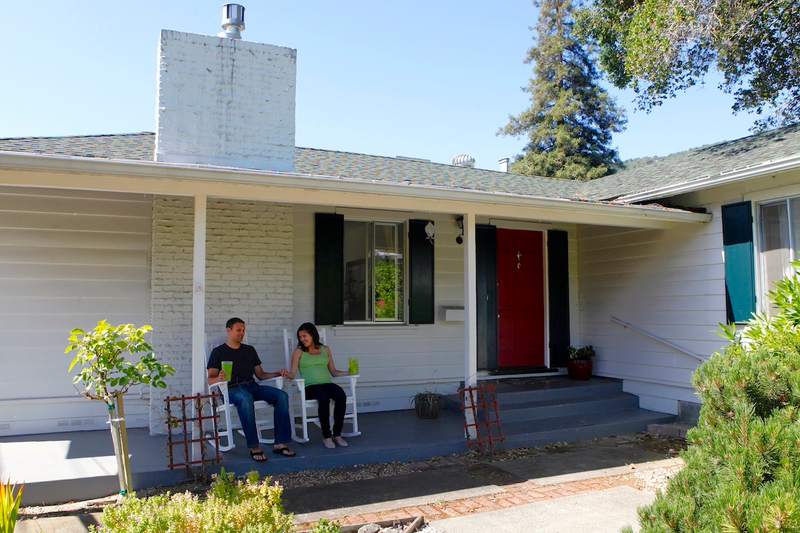Tackling a major kitchen remodel? Want to add a second bathroom to your home? Or maybe it’s time to add that second-floor master bathroom suite that you’ve long coveted. A home equity line of credit, better known as a HELOC, can help.
If you’ve built equity in your home, you might be able to qualify for a HELOC. And if you do, you can use the money you borrow for whatever you like.
What is a HELOC and how does it work? Here are the basics.
What Is A HELOC?
A HELOC is a type of home equity loan that’s a bit like a credit card with a credit limit based on the equity in your home.
Equity is the difference between what you owe on your mortgage and what your home is worth. If your home is worth $380,000 and you owe $200,000 on your mortgage, you have $180,000 of equity.
You can borrow against that equity with a HELOC. If you have $180,000 in equity, your lender might approve you for a HELOC with a line of credit of $130,000.
Unlike with a standard home equity loan, with a HELOC, you only pay back what you borrow. Say you have that line of credit of $130,000. If you borrow $70,000 to renovate your kitchen, you’ll only pay back that $70,000, with interest. If you also borrow $20,000 to add a bathroom, you’ll pay back $90,000 plus interest. That’s from the $70,000 for your kitchen remodel and the $20,000 for your bathroom addition.
HELOCs generally come with variable interest rates. This means that the interest rate on your HELOC can rise or fall during the life of your loan, depending on the performance of whatever economic indices that your HELOC is tied to.
Some lenders offer fixed-rate HELOCs in which your interest rate will never change. It’s easier to plan for your payment with these HELOCs because their interest rates and monthly payments won’t change during its term. These HELOCs, though, tend to come with initial interest rates that are higher than the rates you’d initially get with a variable-rate HELOC.
Compare Home Equity Offers From Verified Lenders:
How Does A HELOC Work?
HELOCs usually come with terms ranging from 5 to 30 years. Unlike other home equity loans, though, your HELOC will feature two distinct phases, the draw period in which you can borrow money and the repayment period in which you pay back what you’ve drawn.
Draw Period
During the draw period, you can borrow money up to your HELOC’s credit limit. Say you qualify for a HELOC of $90,000. During the draw period, you can borrow up to that amount.
It can vary by lender, but a HELOC’s draw period typically lasts 10 years. During the draw period, most lenders require that you only pay the interest on what you borrow. This means that your monthly payments, depending on how much you borrow during this period, tend to be lower.
Repayment Period
Once your HELOC’s draw period ends, your loan enters its repayment period and you can no longer draw funds. During the repayment period, you’ll have to pay back what you borrowed – your loan’s principal balance – and the interest on this amount. This means that your monthly payments will rise during this period.
How much you pay each month depends on how much you borrowed during the draw period, your interest rate and your loan’s term. If you took out a 30-year HELOC with a 10-year draw period, your repayment period will last 20 years.
How Much Can You Borrow With A HELOC?
How much you can borrow with a HELOC varies by lender and how much equity you’ve built. Most lenders want their borrowers to maintain an 80% loan-to-value (LTV) ratio. This means that you’ll typically be able to borrow up to 80% of your home’s value with a HELOC.
See What You Qualify For
Buy A Home
Discover mortgage options that fit your unique financial needs.

Refinance
Refinance your mortgage to have more money for what matters.
Tap Into Equity
Use your home’s equity and unlock cash to achieve your goals.
What Can You Use A HELOC For?
You can borrow against your HELOC for any type of purchase you’d like. That doesn’t mean that some uses of a HELOC don’t make more financial sense than others. It’s typically best to use a HELOC to help pay for big projects or one-off purchases. Unlike your credit card, you shouldn’t borrow against your HELOC for daily purchases.
Home Improvement
One of the best uses for a HELOC is to fund home improvement projects. If you use a HELOC to help pay for kitchen remodels, bathroom updates, a master bedroom addition or any project that increases the value of your home, you can deduct the interest that you pay on the money that you borrow on your income taxes.
This can be a lucrative tax break. If you took on your HELOC debt on Dec. 16, 2017, or later, you are allowed to deduct the interest on up to $750,000 of combined mortgage debt.
According to the IRS, you can only deduct interest on mortgage debt that you use to buy, build or substantially improve a home. Using a HELOC to fund a home improvement project would fall into that latter category.
Debt Consolidation
You can also borrow money with a HELOC to consolidate high-interest-rate debt, including personal loans and credit card debt.
This can make financial sense because the interest rates attached to HELOCs are generally lower than those that come with personal loans and credit cards. Say you have $20,000 of credit card debt at an interest rate of 21%. You might borrow $20,000 against your HELOC with a lower interest rate of 7%. You can then use that $20,000 to pay off your credit card debt. You still have $20,000 worth of debt, but because the interest rate on your new debt is so much lower, you’ll pay far less in interest to pay it off.
Make sure that you can make your HELOC’s payments on time. With a HELOC, your home acts as collateral. If you stop making your payments, your lender can foreclose on your home.
Remember, also, that you can’t deduct the interest on a HELOC if you use it to pay off your credit card debt.
Buy Or Invest In Another Property
You can use the funds from a HELOC to help cover the down payment costs of buying an investment property. The goal is that whatever investment property you buy increases in value and generates income. For example, you might use your HELOC funds to cover the down payment you’d need to buy an apartment building. You can then charge rent to help cover the costs of this new building’s mortgage. If the property increases in value, you can eventually sell it for a solid profit.
Just make sure you can afford the new mortgage payment that comes with your investment property and your HELOC’s repayment costs, especially after your HELOC enters its repayment period.
Education
You can use the money from a HELOC to help cover the costs of your child’s college tuition. Be careful, though. You could put your house at risk if you can’t afford your monthly HELOC payments. You might consider federal and private student loans instead of a HELOC. Even if you fall behind on these loans, your lender won’t be able to foreclose on your home.
Emergency Fund
Financial advisors typically recommend that you build an emergency fund with enough money to cover 3 – 6 months of daily living expenses. It can be difficult to gather this much money. You could, though, take out a HELOC and borrow enough from it to build an emergency fund that you could dip into to cover unexpected repairs or expenses. Because HELOC dollars come with lower interest rates, this could make more sense than relying on credit cards to cover emergency expenses.
Again, though, your house acts as collateral with a HELOC. If you fall behind on your monthly payments, your lender could start the foreclosure process. Make sure you can afford your HELOC payments, both during the draw and repayment periods before you use a line of credit to build an emergency fund.
How To Apply For A HELOC
Applying for a HELOC is like applying for any mortgage loan: You’ll need to find a lender and provide the necessary paperwork to verify that your income is enough to afford your HELOC’s monthly payments.
1. Check Your Finances
You’ll need to make sure you can afford a new HELOC payment, both during the draw period and the higher payment that comes during the repayment phase. To do this, create a household budget listing your monthly income and expenses, including those expenses that fluctuate, such as your utility bill and estimated healthcare costs, and discretionary expenses such as eating out and entertainment.
Once you have your expenses and income listed, you can determine how much you can afford to spend on another regular monthly payment.
You should also order a copy of your three-digit FICO® credit score. This score tells lenders how well you’ve managed your debts and paid your bills. The higher this score, the lower the interest rate on your new HELOC.
2. Shop For A Lender
You don’t have to apply with the mortgage lender that originated your primary home loan. You can shop around with several lenders to find the lowest fees and interest rates. You can get pre-approved– a process in which lenders determine how much they are willing to lend you at what interest rate – with multiple lnders to find the one that will provide you with your desired HELOC credit limit at the lowest interest rate and closing costs.
3. Submit An Application
Once you choose your lender, you can officially apply for a HELOC. You can usually do this online, filling out a loan application that requests such information as your full name, Social Security number, current address, mortgage balance, monthly debts and monthly income.
4. Go Through Underwriting
Once you fill out your application, your lender will begin the underwriting process, in which it verifies your income, checks your credit and makes sure you can afford a new monthly payment.
You might have to provide your lender with copies of such documents as your last two paycheck stubs, last 2 months of bank account statements, last 2 years of income tax returns and last 2 years of W-2 statements.
5. Open Your HELOC Account
Once your HELOC is approved, you can begin borrowing against it. Remember, you can only borrow up to your approved credit limit. And you only pay back what you borrow.
6. Start Making Your Payments
Once you borrow against your HELOC, you’ll start making monthly payments. During the first several years of your HELOC, the draw period, you’ll only pay back the interest on what you borrowed. During the repayment period, you’ll pay back interest while also making payments on the principal of what you borrowed, meaning that your monthly payment will increase, usually significantly.
What Are Some Alternatives To A HELOC?
A HELOC isn’t the only way to borrow against your home’s equity. Here are some other options.
Home Equity Loan Vs. HELOC
Though they have many similarities, there are some key differences between a home equity loan and a HELOC. With a home equity loan, you receive your money in one lump sum, and you pay it back with regular monthly payments with interest. If you borrow $70,000 with a home equity loan, you’ll receive your money as a single check or deposit. You’ll then pay back that $70,000 each month over the term of your loan. As with a HELOC, if you use the funds from a home equity loan for home improvements that increase the value of your home, you can deduct the interest that you pay.
Cash-Out Refinance Vs. HELOC
There are important differences between a cash-out refinance and a HELOC, too. In a cash-out refinance, you refinance to a new loan for a higher amount than you owe on your current mortgage. You then receive the extra funds as a single payment. You can use that money for whatever you want. Say you owe $200,000 on your mortgage. You can refinance to a mortgage of $280,000 and receive a check or deposit of $80,000 that you can use however you’d like. You will have to pay back the full $280,000 that you borrowed with regular monthly payments with interest. With a refinance, you’re replacing your original loan, meaning you’ll have one mortgage. With a HELOC, you’re getting a second mortgage, meaning you’ll have two mortgage payments each month.
Personal Loan
A personal loan and a HELOC also come with key differences. In a personal loan, your home is not your collateral. In fact, a personal loan has no collateral at all. If you stop making your personal loan payments, your lender can’t foreclose on your home or repossess your car. Because personal loans are riskier for lenders, they typically charge higher interest rates than what you’d get with a HELOC or home equity loan. You also might not be able to borrow as much depending on your credit score, savings and income. Whatever you borrow, you’ll pay back in regular monthly payments with interest.
What Are The Pros And Cons Of Using A HELOC?
As with all forms of debt, HELOCs come with both positives and negatives.
Pros Of Using A HELOC
- Lower interest rates: HELOCs tend to come with lower interest rates than do credit cards or personal loans. This makes HELOCs a more affordable way to borrow money.
- Longer repayment period: You can generally take out a HELOC with a term of up to 30 years. Because you have a longer time in which to repay the money you’ve borrowed, you pay less each month, helping your household’s monthly cash flow.
- Access money when you need it: With a HELOC, you can access your funds whenever you’d like, as long as it’s during your line of credit’s draw period, which typically lasts for up to 10 years.
- Flexibility of use: You can use the funds for a HELOC for whatever you like, though you’ll only be able to deduct the interest that you pay if you use your line of credit to fund home improvements that increase the value of your home.
Cons Of Using A HELOC
- Risk of losing home: Your home is collateral in a HELOC. This means that if you stop making your payments, your lender could foreclose on your residence. You could lose your home.
- Variable interest rates: Most HELOCs come with variable interest rates, rates that can change during the life of your loan. This means that, when your HELOC’s interest rate rises, it’ll boost your monthly payment, especially during your line of credit’s repayment period.
- Closing costs: HELOC’s aren’t free. Your lender will charge you closing costs to originate your HELOC. These costs vary, but you can expect to pay from 2% to 6% of the amount you are borrowing in closing costs.
HELOC Frequently Asked Questions
What kind of interest do you pay with a HELOC?
Most HELOCs come with variable interest rates. Your rate will rise or fall throughout the life of your loan depending on the economic index it’s tied to. Usually, your rate will rise over time, so make sure that you can afford the higher monthly payments that come with a higher interest rate.
Do you pay closing costs with a HELOC?
Lenders do charge closing costs when originating a HELOC. These costs vary, but you can expect to pay from 2% to 6% of what you borrow. If you take out a HELOC for $100,000, you can expect to pay from $2,000 to $6,000 in closing costs.
Is there a credit limit with a HELOC?
Your credit limit with a HELOC is based on the value in your home. Most lenders will let you borrow a percentage of your available equity. Maybe you have $120,000 of equity in your home. Your lender might let you take out a HELOC with a credit limit of $90,000.
The Bottom Line
A HELOC offers a flexible way for homeowners to borrow against their residence’s equity.
Get a Home Equity Loan online.
Let’s match you up with lenders who can help with your unique financial situation.

Dan Rafter
Dan Rafter has been writing about personal finance for more than 15 years. He's written for publications such as The Washington Post, Chicago Tribune and Wise Bread.












